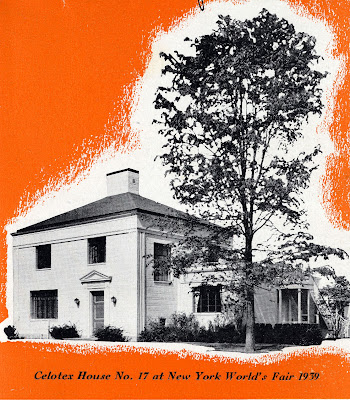Architect-builder Edwin L. Markel (1888-1956) completed a new residence for his family in 1923 and invited the public to visit his "Happy Home." Located at 4416 South Galvez Street, the house featured Celotex insulating lumber as an interior plaster base and as a sheathing under the exterior stucco and brick. Markel selected Celotex after visiting J.W. Thompson's Building Material exhibit (shown below) in the Weis Building (830 Common Street).
In November 1922, realtor Meyer Eiseman announced that Louisiana would soon boast the only town in the world to be built of bagasse. Located on the former Ames Farms tract, the celotex houses were intended to lodge plant workers after the company invested $1,000,000 in the West Bank riverfront property.(1)
The Celotex Corporation recognized the model home as an effective marketing device. It hired New York architects Henry Otis Chapman, Jr. (1898-1967) and Harold W. Beder (1876-1967) to design its demonstration house (shown below) for the 1939 New York World's Fair's "Town of Tomorrow".
Claiming Celotex products to be completely termite- and dry rot-resistant, the company published brochures and souvenir books for fair-goers. Savings and Loan Day was held on September 30, and the Celotex House hosted hundreds of association delegates who came to view the structure and its grounds.
After the Second World War, Celotex heavily promoted its ominous-sounding product, "Cemesto."(2) Precision-Cut Homes was a local builder that established a fireproof concrete block industrial plant mobilized for Cemesto prefabricated construction. It launched its model homes first in Jefferson Parish, at Cross and Second Streets.(3) The company could supply homes to qualified veterans for a mere $5,500 and offered dealer franchises to those located within a 300-mile radius. Precision-Cut was a short-lived venture: its 2500 Calliope Street plant was advertised for sale in August 1947.
(1)"Builders to Use Cane Pulp Board." The Times-Picayune 7 November 1922. Cambridge landscape architect John Nolen planned the Celotex "Farm City" of Clewiston, Florida for the company (1923-24).
(2)Celotex had launched Cemesto-Board in 1931.For more on Cemesto, see Jack Breihan, "Glenn L. Martin Aircraft Company." DOCOMOMO_US Newsletter (Summer 2008): p. 7. URL: http://www.docomomo-us.org/files/DOCONewsSummer08.pdf
(3)"New Plant for Pre-Fab Houses." The Times-Picayune 19 May 1946.
Images above: Top: "Celotex Insulating Lumber." Advertisement. The Times-Picayune 4 February 1923.
Center and Bottom: The Celotex Corporation. "Thanks for Dropping in to see the Celotex House." Brochure. Chicago: The Company, 1930. Architectural Trade Catalogs, Southeastern Architectural Archive, Special Collections Division, Tulane University Libraries.
Friday, June 5, 2015
Subscribe to:
Post Comments (Atom)



No comments:
Post a Comment